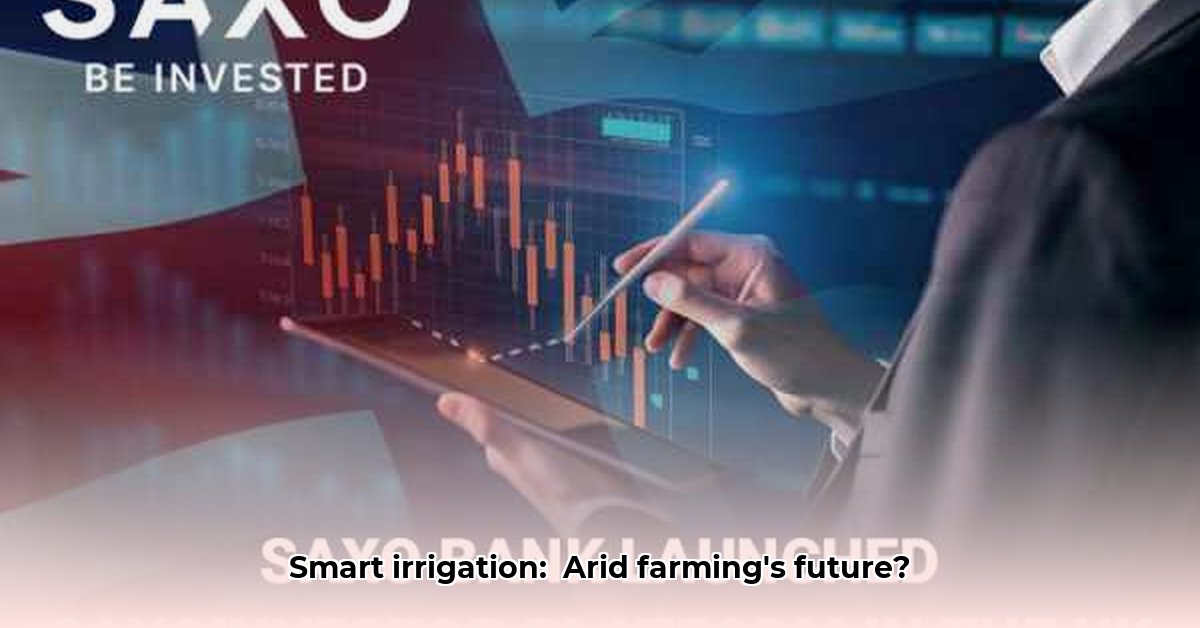
Facing the Facts: Water's a Precious Resource in Arid Farming
Farming in South Africa's arid regions presents a constant battle against water scarcity. Traditional irrigation methods often prove inefficient, leading to wasted water and reduced crop yields. This reality poses a significant challenge to farmers, impacting profitability and long-term sustainability. Precision irrigation, however, offers a powerful solution, enabling farmers to optimise water use and improve their bottom line. For more on efficient farming practices, see this useful resource.
SaxoInvestor: Your Partner in Smart Water Management
Platforms like SaxoInvestor are transforming the landscape of arid-land farming by connecting farmers with crucial resources. Access to real-time market information, including water pricing data, empowers farmers to make informed decisions regarding irrigation scheduling, thereby minimising costs and maximising yields. Moreover, SaxoInvestor facilitates access to funding and expert advice, essential components of successful precision irrigation adoption. "SaxoInvestor isn't just technology; it's a strategic partnership for sustainable growth," says Dr. Nomusa Mthembu, Agricultural Economist at Stellenbosch University.
Getting Water Where It's Needed: Precision Irrigation Techniques
Several precision irrigation methods exist, each suited to specific needs and contexts:
- Drip Irrigation: This method delivers water directly to plant roots via a network of tubes, minimising evaporation and runoff. It's highly efficient but requires careful planning and maintenance.
- Sprinkler Irrigation: While less precise than drip irrigation, sprinklers remain effective for certain crops and terrains. Careful consideration of wind patterns and water pressure is crucial for optimal results.
- Subsurface Irrigation: Water is delivered beneath the soil surface, reducing evaporation and weed growth. However, this technique requires specific soil conditions and may necessitate higher initial investment.
The choice of irrigation method depends on various factors, including crop type, soil characteristics, and budget constraints. Careful assessment is vital for achieving the optimal balance between efficiency and cost-effectiveness.
The Financial Considerations: Investing in Efficiency
The significant upfront investment required for precision irrigation systems can initially deter some farmers. SaxoInvestor assists farmers in navigating this hurdle by providing guidance on various funding options, conducting feasibility studies to demonstrate return on investment (ROI), and facilitating connections with potential investors interested in sustainable agriculture projects. "Precision Irrigation might seem expensive initially. But the long-term gains in water conservation and crop yield far outweigh these upfront costs," notes Mr. Thabo Moloi, a successful maize farmer in the Northern Cape who has adopted precision irrigation.
Risk Management in Precision Irrigation Systems
Implementing a precision irrigation system requires careful consideration of potential risks:
- Equipment Malfunctions: Regular maintenance schedules are essential for ensuring optimal system functionality and preventing costly breakdowns.
- Adverse Weather Conditions: Unexpected variations in weather patterns can disrupt irrigation schedules, highlighting the need for flexible management strategies.
- Cybersecurity Threats: Protecting data from cyberattacks is crucial, ensuring the integrity and security of valuable farm information. This includes robust password protocols and regular software updates.
Implementing preventative measures and establishing contingency plans are key to mitigating these risks and ensuring consistent system operation, allowing for a more sustainable future for the farmer.
The Future of Arid Farming: Embracing Sustainable Solutions
Precision irrigation is not merely a technological advancement but a paradigm shift in arid land farming practices. By optimising water usage, maximising crop yields, and promoting environmental sustainability, it contributes significantly to food security and economic stability in water-stressed regions. The adoption of precision irrigation solutions, facilitated by platforms like SaxoInvestor, is crucial for securing a more prosperous and sustainable future for South African agriculture.
How to Obtain Government Subsidies for Precision Irrigation
Understanding the Funding Landscape
Government subsidies play a critical role in making precision irrigation more accessible to farmers. Numerous programs at national and provincial levels offer financial support for sustainable agriculture initiatives. However, accessing these funds requires clear planning and a well-structured application strategy. Successful applicants clearly articulate the project's environmental benefits and economic potential to the government.
A Step-by-Step Guide to Securing Funding
- Research Funding Programs: Thoroughly research available government subsidies and grants related to water conservation and sustainable agriculture.
- Assess Eligibility Criteria: Carefully review the specific eligibility requirements for each program to ensure your farming operation and proposed project are suitable.
- Develop a Comprehensive Proposal: Craft a detailed and convincing proposal outlining the project's objectives, budget, anticipated impact, and alignment with government priorities. A strong proposal provides clear evidence of long-term sustainability.
- Seek Expert Guidance: Consult with agricultural extension officers and other specialists to improve your proposal and learn about the most suitable technologies. They are an invaluable resource.
- Submit a Complete Application: Adhere meticulously to all application guidelines and deadlines. Thoroughness is critical for a successful application.
- Monitor Application Status: Regularly track the progress of your application and address any inquiries from the funding agency promptly.
Choosing the Right Precision Irrigation Technology
The selection of an appropriate technology is critical for a successful project. Several key factors must be considered:
- Sensor Technology: Employing GPS, soil moisture sensors, and remote sensing technologies enhances data collection and allows for tailored irrigation management.
- Irrigation System Design: Choosing an appropriate irrigation system (drip, sprinkler, or subsurface) depends on the specific characteristics of your farm and the crops being cultivated.
- Data Management Software: Selecting user-friendly software that integrates with your hardware setup and facilitates effective data analysis will help optimize the system's performance and longevity.
Remember to thoroughly research the long-term maintenance requirements of your chosen technology.
Maximising the Impact: Highlighting Key Benefits in Your Application
A successful proposal emphasises the environmental and economic benefits of your project. Quantifiable evidence demonstrating improved water use efficiency, reduced negative environmental impact, enhanced crop yields, and improved profitability will significantly increase your chances of securing funding. Show the government that you have a sustainable long-term vision.